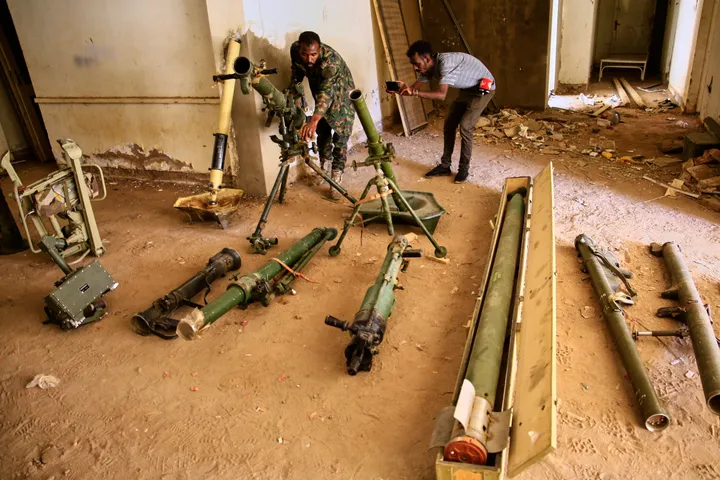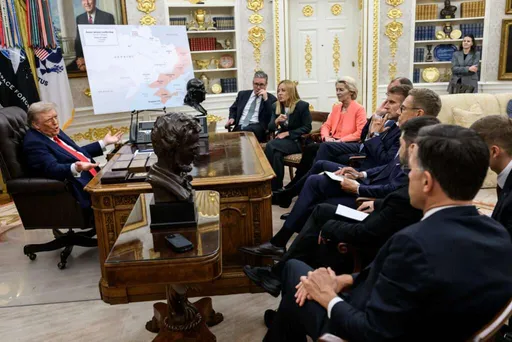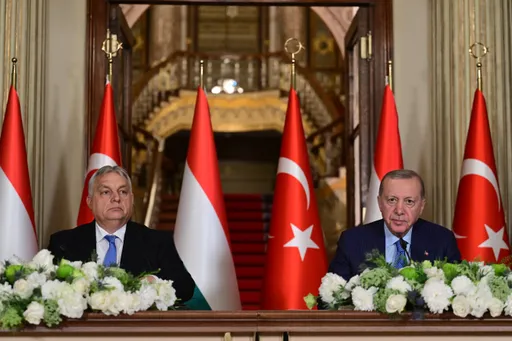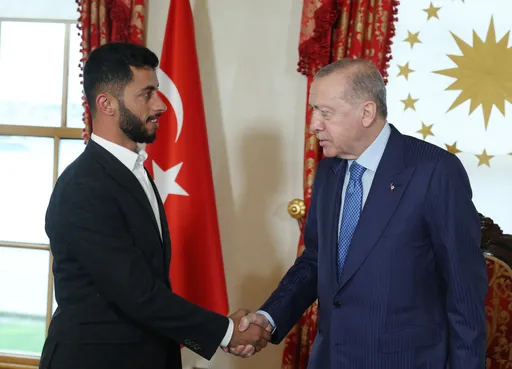It has been twenty-three years since the United States invaded Afghanistan, following its declaration of war in the aftermath of 9/11, when 2,977 people died after an Al Qaeda-led attack hijacked four US airliners, crashing them into sites in New York and Washington.
The attacks became a premise for US's so-called 'war on terror', reshaping global security policies and creating dark sites, such as Bagram and Guantanamo Bay — the notorious prisons that became synonymous with unlawful detention and torture, where human rights and legal norms never seemed to matter.
Moazzam Begg, a former Guantanamo Bay detainee, vividly recalls the day Pakistani security personnel rounded him up in the country's capital Islamabad in March 2002, a few months after the 9/11 attack.
"I was held without charge or trial, kidnapped in front of my family in Pakistan where I was," he says, emphasising the trauma of detention without trial inflicted not only on the prisoners but their loved ones as well.
His crime? He had supported freedom struggles of Bosniaks and Chechens, including lending financial support to both causes — something Begg has openly admitted to. But British and the US intel accused him of training Al Qaeda terrorists, an accusation he has vehemently refuted.
The terrorism charge against him was never substantiated.
"It is not that you are a terrorism suspect because there are many terrorists who are non-Muslim, none of them go to Guantanamo," Begg tells TRT World. "The primary condition is that you have to be a Muslim."
By the time Begg was released in 2005, over 700 men and boys — all Muslims by faith — and from nearly every part of the world had been imprisoned in Guantanamo, many of them held for years without charge, according to the American Civil Liberties Union.
"The second criterion is people who are handed over without any legal process," Begg says.
Like hundreds of others, Begg was swept into a system designed to detain and dehumanise those caught in the crosshairs of US foreign policy. He was kept in both the notorious Bagram prison in Afghanistan and later in Guantanamo.
As Begg would later discover, many detainees were handed over by foreign governments for cash bounties, with some governments openly admitting to receiving "millions of dollars from the CIA for handing people over without any legal process" — a fact corroborated by the Center for Constitutional Rights.
Begg's experiences in Bagram and Guantanamo were harrowing.
"When prisoners came out, they spoke about the abuse, the desecration of the Quran, the stripping, the beating, the torture, the rape, the detention without trial," he recalls. "All of this was done by a country that claimed to be the most powerful and vociferous bastion of human rights and freedom."
These tortures were part of what Begg and human rights advocates describe as a systematic effort to degrade and dehumanise prisoners. The goal, it seemed, was not just intelligence gathering, but to break the spirit of the detainees.
"They wanted to strip us of our identity," Begg says, emphasising the psychological as well as physical abuses.
Begg's fluent English, Arabic and Urdu allowed him to communicate with fellow prisoners and advocate for their rights — a role he has continued in his post-release work with the NGO Cage International.
Abu Zubaydah: The forever prisoner
Among the most infamous cases from Guantanamo is that of Abu Zubaydah, a Palestinian who remains imprisoned without charge. Zubaydah's case represents the extreme measures the US government has taken to justify its detention and torture programmes.
"They placed him in a coffin while he was alive, naked, and filled it with water till he was drowning," Begg says.
Initially, Zubaydah was painted as a high-ranking member of Al Qaeda, even labelled as the group's founder Osama bin Laden's right-hand man. But it was later revealed that these claims were false, and Zubaydah had no direct involvement in the 9/11 attacks.
"They told lies about him in the beginning … He had no knowledge or connection to the 9/11 attacks," Begg says.
The CIA's interrogation methods used on Zubaydah and other inmates were extreme, as later confirmed by the 2014 "torture report" produced by the US's Senate Select Committee on Intelligence.
Zubaydah was subjected to waterboarding 83 times, stress positions, sleep deprivation, and sexual humiliation among other extreme torture measures.
"The US developed its entire torture programme to break Abu Zubaydah," Begg says. "He remains in Guantanamo without charge, without trial. The Americans claim he is too dangerous to release and he is too innocent to charge."
Zubaydah's drawings of his torture, smuggled out through his legal team, have been published in The New York Times and serve as chilling reminders of the abuse he endured.
"These sketches show the horror of what was done to him," Begg adds.
Begg believes Zubaydah's case, like many others, reflects a larger issue with Guantanamo: the concept of the 'forever prisoner': "Not because of what Abu Zubaydah did but because of what was done to him."
Aafia Siddiqui: A woman forgotten
While most detainees were men, one case stands out: that of Aafia Siddiqui. Her story exemplifies how the US's so called 'war on terror' ensnared not only men but women and children.
Siddiqui, a Pakistani neuroscientist, was arrested in Afghanistan in 2008 after mysteriously disappearing from Karachi, Pakistan, in 2003. She was found in US custody five years later in a different country. Her family claims she was taken by Pakistani authorities, who initially acknowledged her detention but later denied it.
Following her arrest in Ghazni, Afghanistan, Siddiqui was convicted two years later, in 2010, in a US court of attempting to kill American soldiers.
What is particularly interesting about Siddiqui's case is that she was never tried for her alleged links to Al Qaeda — the reason for her original appearance on the FBI's most-wanted list in 2004.
Clive Stafford Smith, her lawyer, has consistently argued that Siddiqui's trial was deeply flawed and based on fabricated evidence.
"Siddiqui's case is the most outrageous violation of someone's human rights that I have ever come across," says Smith, who has represented over 80 Guantanamo detainees. "She was really the only woman who went through the rendition and torture process."
What makes her case even more tragic, Smith says, is that her children were also caught up in her abduction.
"The six-month-old Suleiman they apparently dropped on his head and apparently killed," he tells TRT World. "And Mariam, age three, was forcibly adopted into a white Christian-American family and renamed Fatima."
Mariam was held with the American family for seven years and would probably still be there if it were not for Fowzia Siddiqui, Smith says. Fowzia, Siddiqui's sister, has been proactively campaigning for her freedom.
The case of Siddiqui's third child is perhaps the strangest of all. "Ahmed was taken to Kabul, imprisoned at just six years old, and given the name Ehsan Ali," Smith says. "What person in their right mind would do that?"
Fowzia has managed to gain custody of both Mariam and Ahmed, while the fate of Suleiman remains unknown. Nevertheless, Fowzia continues to believe he could still be alive.
"One of the most touching things is that Fowzia creates an updated picture of what Suleiman would look like now, if he is still alive," Smith says.
The evidence presented in Siddiqui's trial defies logic, Smith says, adding that she was jailed for 86 years over unproven claims that she had allegedly fired a couple of rounds from an M4 machine gun at US soldiers in Afghanistan.
For years, Siddiqui's family has fought for her release, but political negotiations have stalled.
"Pakistan had plenty of opportunities for prisoner exchanges, and America has conducted many with Afghanistan. In the Raymond Davis case in 2012, for instance, they could have done that, but they did not," Smith says, referring to the CIA contractor who shot two men in Lahore, Pakistan, in January 2011.
Davis was released over a month later after the families of the two men were paid $2.4 million in blood money.
Smith believes Siddiqui's fate has become a pawn in larger diplomatic games. Despite the bleakness, hope remains that justice will eventually be served, even if belatedly. "The best we can do is to get her liberty and to get her back with the people who love her," he says.
The infamous legacy of Guantanamo
As Guantanamo Bay marks over two decades of operation, the horrors inflicted upon detainees like Begg and Abu Zubaydah have been well-documented, yet justice remains elusive for many.
"America will never escape the legacy of Guantanamo," says Begg. "It is a stain on their record that they cannot wipe away."
Begg, now a senior director at Cage International, reflects on Guantanamo's broader impact — not just on detainees but on international law and human rights. "Guantanamo showed the world that the rule of law could be suspended for the sake of security. It set a dangerous precedent."
The prison became a symbol of American excesses — where constitutional protections and international conventions were disregarded in the name of counterterrorism.
Human rights organisations have long called for Guantanamo's closure, citing both legal issues and humanitarian costs. The detainees still held there are a mix of those cleared for release but trapped due to political reasons, and those deemed 'forever prisoners' like Abu Zubaydah.
Around 30 prisoners remain at Guantanamo Bay, according to the Center for Constitutional Rights, all of whom have been there for over 15 years. Of these, 19 men have not been charged with any crime, including 16 who have been cleared for release. Currently, there are 11 active cases, and only one prisoner has been convicted.
"It is a nightmare that never ends for them," Begg says. "Even after being cleared, they are stuck in limbo where no country will take them back."
Begg highlights concerns about the aftermath of the trauma endured by detainees. "These people have been through the worst imaginable experiences," he says. "And for many, the psychological scars will last a lifetime."
Even after their release, former detainees face stigma, isolation, and ongoing mental health challenges. "Some come home to find their children grown up without them, or worse, that their parents have passed away."
Former US President Barack Obama promised to close the prison entirely but failed to do so. Later, President Donald Trump chose to keep it open.
A report published by The New York Times three years ago referred to Guantanamo prison as "the most expensive on earth", where the annual cost of operating the facility amounted to $13 million per prisoner, with the total yearly expense exceeding $540 million.
Long fight for justice
For Siddiqui, the trauma of detention has left her deeply scarred. She is currently held in a Texas prison where she continues to face abuse.
"Carswell prison, where Siddiqui is being held, is worse than Guantanamo ... She has been sexually abused there, and 13 guards have been convicted of rape in that facility," Smith, Siddiqui's lawyer says.
"We are fighting to get her out. It is a long battle."
Smith, who has spent years defending detainees like Begg and Siddiqui, remains one of the few voices challenging the US government's narrative.
"The tragedy is that we have thrown 1,000 years of the evolution of the rule of law out the window," he says bluntly.
Smith's frustration with the legal system is palpable, particularly in Siddiqui's case. Her plight transcends her own suffering; it encapsulates the systemic abuse inherent in the 'war on terror', which Smith prefers to call the "war of terror".
"Imagine the trauma of being tortured and knowing your children are lost, hurt, or worse," he says.
Despite the hurdles, Smith remains optimistic about Siddiqui's future. He continues to file legal motions, including a recent 56,600-word clemency petition submitted to the US government.
"She will never get justice because there is no way you can repair the damage that has been done to her. But at the same time, the best we can do is to get her liberty and to get her back with the people who love her," he says.
"And we will do that. I do not care how long it takes, we will do that."
























